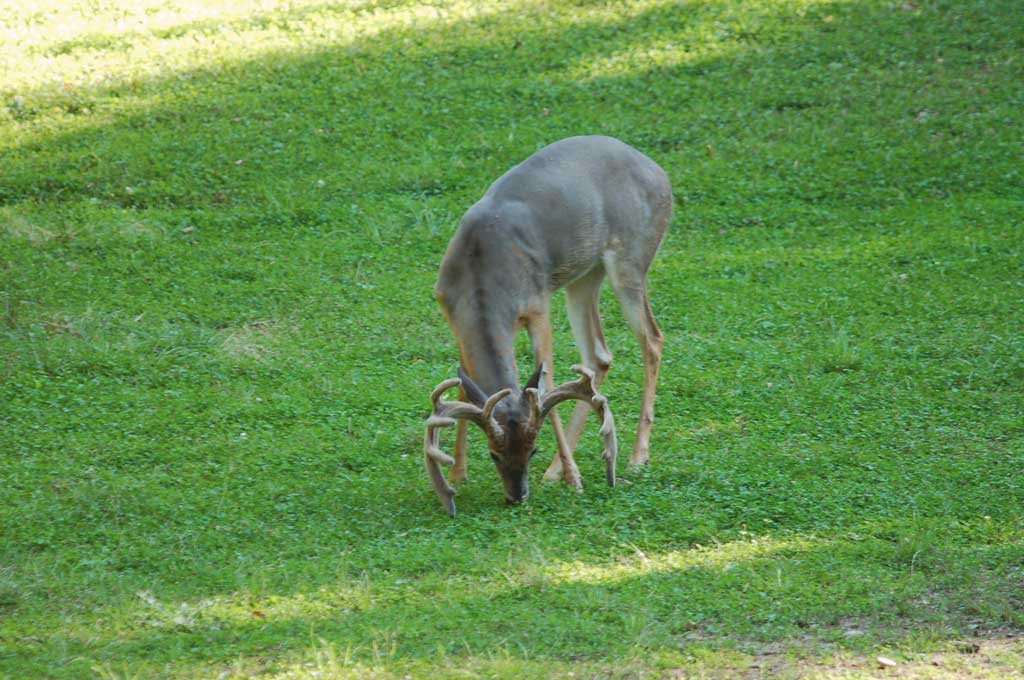There are a lot of mediocre food plots in the deer woods. Heck, “mediocre” is a pretty generous adjective for some of the ones I have seen. 50lbs of rye grass seed on a one acre clearing scratched out in the sand might accurately be called a “green field,” but a food plot? That’s a stretch.
Maybe that description hits a little close to home for you. To be fair, creating a really awesome food plot can be surprisingly difficult. It can require some pretty expensive equipment, a lot of sweat-equity, and a better-than-average knowledge of chemistry, botany, geology, and other disciplines that for many of us are just a distant highschool memory.
A big part of building a better food plot is buying better deer food plot seed. But which seed? Walk into your local feed supply and it’s easy to be overwhelmed by the choices. Rape, turnips, clover, peas, oats, sorghum, chickory…they all vaguely ring a bell as names of plants you’ve been told that deer just love. But which ones should you buy?
Seeds For Deer Food Plot
Let’s start by going over some of the best and most common seeds planted for deer food plots.
Grass Seed For Deer
Didn’t we just poke fun at grass? Kinda. While rye grass has its uses (it can thrive in low-quality soils where other seeds won’t grow, for example) it’s not a very nutritious deer food. But rye grass is just one member of the incredibly large grass family. Let’s look at a couple of better grass seeds for deer food plots.
Oats For Deer
Yep…oats are a type of grass! I prefer corn grits to oatmeal for breakfast, personally. But the facts are that oats are a much more nutritious deer food than corn, and they will thrive long after corn has given up the ghost.
Frost-tolerant oats such as Buck Forage Oats can be an awesome way to provide high-quality deer food throughout the coldest parts of winter. This is because Buck Forage Oats have enhanced tolerance to freezing temperatures. They can continue to grow and remain green even after light frosts or cold snaps. This resilience ensures a longer availability of nutritious forage for deer throughout the fall and winter seasons.
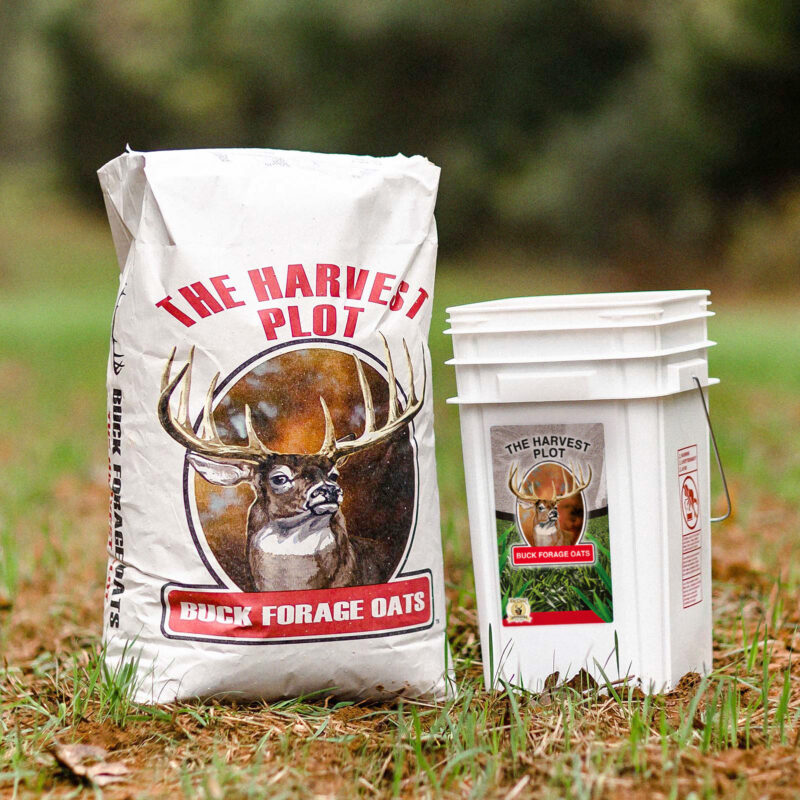
Buck Forage Oats are also a carbohydrate powerhouse, providing energy-rich forage that can help deer maintain body condition during the colder months when energy demands are higher. Their sweet taste and tender leaves make them highly appealing to deer.
Triticale For Deer
Triticale is a hybrid grain crop that is derived from crossing wheat (Triticum) and rye (Secale). It combines the favorable characteristics of both parent plants, resulting in a versatile and nutritious forage option.
Triticale offers excellent nutritional value for deer. It contains a balanced combination of protein, carbohydrates, and essential minerals. The foliage of triticale is highly palatable and digestible even at maturity, making it an attractive forage option for deer.
It’s also known for its high yield potential. It can produce substantial amounts of forage in dense stands, making it an efficient choice for attracting and sustaining deer populations.
Triticale also is adaptable to a wide range of soil types and growing conditions. It can grow well in various soil textures, and is relatively drought tolerant.
(Broadleaves) Forbs For Deer
Much like the grass family, forbs are an incredibly well-populated category of plants. Deer love forbs, whether planted by hunters and land managers or just naturally found in the environment. For hunters, one forb in particular stands out as an awesome performer.
Chicory For Deer
Chicory is a perennial plant, meaning it can persist and provide forage for multiple years without the need for annual replanting. It is often included in deer food plots due to its high nutritional value and attractiveness to deer. It contains significant levels of protein, minerals (such as calcium and phosphorus), and vitamins, offering a valuable food source that can support deer health, antler growth, and overall herd condition.
One of the key benefits of chicory as a deer plot seed is its ability to maintain its nutritional value and productivity even during periods of stress or drought. It has a deep taproot that allows it to access moisture and nutrients from deeper soil layers, ensuring its survival and providing consistent forage for deer throughout the growing season.
Legumes For Deer
We’ve covered brassicas, grasses, and forbs; all of which are awesome seeds to plant in your deer food plot. But our last mention has a pretty cool trick up its sleeve that provides a lot of added value to a food plot.
Clover For Deer
The coolest thing about legumes such as clover is that they are able to fix atmospheric nitrogen. Or, more specifically, the bacteria that lives in its root nodules can fix nitrogen. Technicalities aside, this nitrogen fixation improves soil fertility, benefiting not only the clover but also the surrounding vegetation in the food plot.
Clover is also a perennial, so you can plant it once and enjoy its nitrogen-fixing benefits for several years. And like every other plant we’ve mentioned, clover is an exceptionally nutritious and attractive forage option for whitetail deer.
Deer Food Plot Seed Mixes Points To Consider With Dr. Deer
So what’s the best food plot seed to plant in your food plots this season? That’s a question with as many different answers as there are hunters. But some voices are more qualified to weigh in than others.
We recently got the chance to sit down with Dr. James Kroll on an episode of the Huntin’ Land Podcast. Dr. Kroll, or “Dr. Deer” to most people, is one of the leading whitetail experts in the US and currently serves as Professor Emeritus of Forest Wildlife Management at Stephen F. Austin State University. He has decades of experience planting food plot seeds and seeing what deer respond both to, and he was kind enough to share his knowledge with us.
“People have been looking for the “magic bean” forever when it comes to choosing the best food plot seeds,” says Kroll, “but it just doesn’t work that way. What grows well in some soils won’t grow well in others, and even on the same piece of property differences in soil type and drainages can change your growing parameters and affect your end results. But it has been my experience in the research that I have seen conducted that you cannot beat a mixture of cereal grains and legumes. In particular, oats and clover are what we call “first choice” deer foods. Deer will walk across other foods to get to those.”
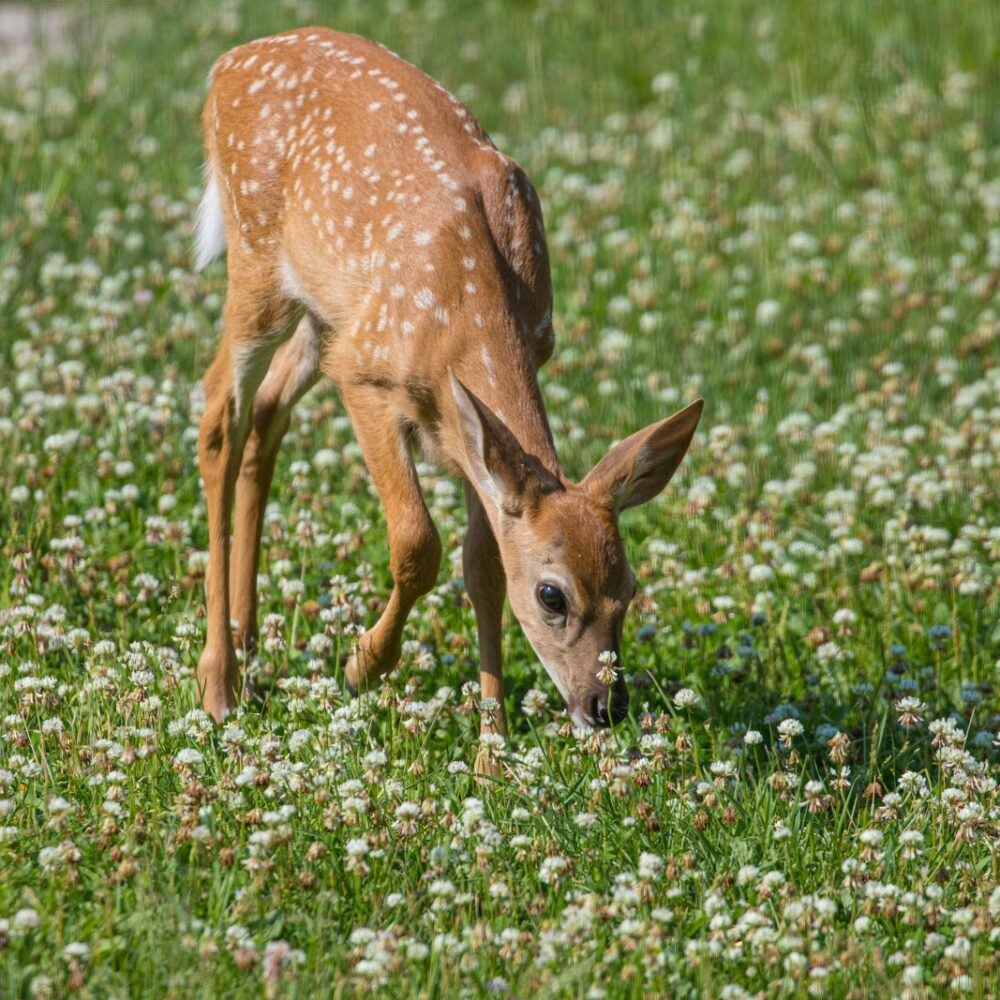
“If there ever was a combination of food plot seed choice that would work in all places, it would be oats and clover,” continues Dr. Kroll. “If you’re in a really dry and sandy place, you’ll have to substitute rye for oats. And if it’s a really wet bottom, you’d be better off with wheat. But if you can grow oats, that’s the best-case scenario.”
“Based on our early research, I was initially against planting oats for deer food plots because after that first frost, they’re usually gone,” says Kroll. “Back then we usually recommended planting wheat and rye seed for their cold tolerance. But I had a gentleman named John Butler come to me about 40 years ago and ask me if he could give me some oat seeds to use for our research. We planted them, and lo and behold, it got down to 8 degrees that season and the oats didn’t freeze out! He had discovered what later became Buck Forage Oats.”
“Another good plant to consider is chicory,” says Dr. Kroll. “Chicory is a very interesting plant that particularly shines as a companion plant to clover. I’m partial to chicory because it’s very drought tolerant. It’s got a taproot that can go down up to 3ft deep in the soil, and it’s a 3-5 year perennial. Once it’s established even if there’s a severe drought and it kills the top, next year it will be right back. And in most places chicory is also a first choice deer food.
Deer Food Plot Seed Mix Mistakes
While many hunters may be familiar with the mixed bags of food plot seed for deer sitting on the shelves at co-ops and retail stores, Dr. Kroll says that these mixes can be underwhelming when planted in your food plot.
“There’s this idea that deer have to have a lot of variety,” says Kroll. “A lot of companies lean into this idea by offering mixes. But I advise against buying mixes. First of all, if you look at the labels on the back, the plants that are listed on it are listed in order of abundance in the bag. And the most abundant ones are almost always the cheaper, less desirable seeds. Companies also exaggerate how many acres that bag will seed, so you end up under-seeding your plot. And if you buy a bag of mixed seeds and plant it all at one go, it’s impossible to plant each species at its correct depth to ensure germination. One seed, for example, might need to be planted an inch and a half deep. But you’re planting it alongside a seed that needs to be planted an eighth of an inch deep. How do you get them both planted at the correct depth? Tough, right?”
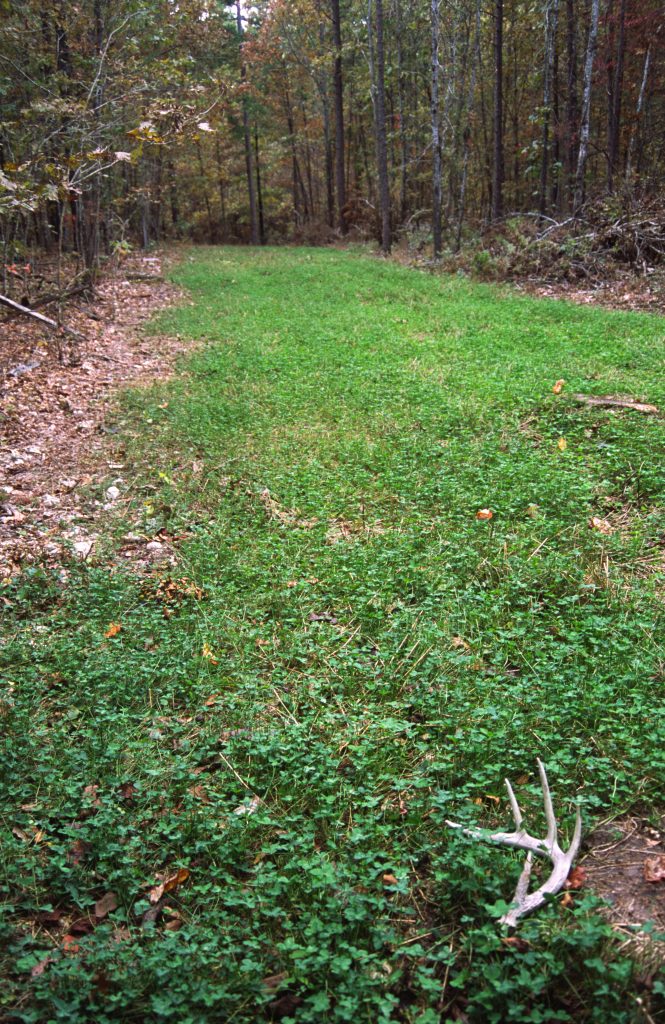
“To top it all off, if you follow what brands put out from year to year and keep up with the seed mix ratios year-to-year, you’ll find that there’ll be different plants at different percentages in the same “product.” That’s because most companies are buying commodity-grade seed to hit a price point for store shelves. It’s not high-quality stuff in that bag. Sometimes they’re literally sweeping up the processing floor to put a mix together for you.”
Overall, according to Dr. Kroll, you’re better off buying your food plot mix components separately, and planting fewer, better strains of each plant as opposed to striving for variety. High quality strains that have been selectively bred as ideal deer forage, such as Buck Forage Oats and Buck Forage’s Chicory, will out-perform bulk seed from the co-op or commercial seed mixes.
Deer Food Plot Seed FAQs
When to plant deer food plots?
The perfect timing for planting deer seed for food plots varies depending on several factors, including your location, selected seed types, and the specific goals you have for the food plot. But there are some general guidelines.
For warm-season crops like soybeans and peas, it is typically best to plant them in the spring or early summer, after the last frost has passed and the soil temperature has warmed up. This timing allows the plants to establish and grow during the warmer months.
Cool-season crops like clover, brassicas (turnips, radishes, kale), oats, wheat, and rye are often planted in late summer or early fall, depending on your region. Planting a few weeks before the first frost allows the plants to establish before winter sets in.
Some food plots consist of a mix of both warm-season and cool-season plants to provide year-round nutrition for deer. This approach involves planting different seeds at different times to ensure a consistent food source throughout the year.
How to plant a food plot for deer?
You could write a whole article on this topic. Heck, you could write several articles, which we have!
Here is the basic step-by-step process, with a few helpful links if you need more information.
- Select the Location: Choose an area for your food plot that is suitable in terms of size, sunlight exposure, and soil quality. Consider factors such as proximity to cover and water sources, prevailing winds, and deer movement patterns. Remember that sometimes, smaller food plots in better locations can outperform larger ones.
- Soil Preparation: Prepare the soil by removing any vegetation, rocks, or debris. Perform a soil test to assess its nutrient composition and pH levels. Based on the test results, add lime or other amendments as needed to optimize soil fertility and pH.
- Seed Selection: Choose appropriate seeds based on your region, climate, and the specific goals of your food plot. Select a variety of seeds that offer different nutritional benefits and thrive in your area’s conditions. Common choices include clover, brassicas, soybeans, oats, and wheat.
- Seedbed Preparation: Use a tractor or ATV with suitable implements to till the soil and create a seedbed. Remove any remaining vegetation, loosen the soil, and create a smooth, firm surface for seed planting. Ensure proper seed-to-soil contact for optimal germination.
- Seed Planting: Plant the seeds using a broadcast spreader, seed drill, or by hand. Small ATV Spreaders can be useful for smaller plots. Follow the recommended seeding rate provided on the seed packaging for accurate distribution.
- Fertilization: Apply fertilizer based on soil test recommendations or use a balanced fertilizer suitable for your chosen seed mix. Follow the instructions regarding application rates and timing to provide the necessary nutrients for plant growth.
- Weed and Pest Control: Implement appropriate weed control measures to minimize competition with the desired food plot plants. This can involve manual removal, herbicide application (if needed and following proper guidelines), or mowing. Take precautions to minimize any adverse effects on deer or other wildlife.
- Maintenance: Regularly monitor and maintain the food plot. This may involve mowing to control weed growth, watering during dry spells, and protecting young plants from browsing by deer or other animals. Consider adding fencing or using exclusionary devices if necessary.
How long after spraying Roundup can I plant a food plot?
This is a tough question to answer without knowing exactly what “Roundup” you are spraying. Roundup is the brand name for a broad-spectrum, glyphosate-based herbicide produced by Monsanto. There are several formulas of Roundup sold for different applications that vary in the concentration of glyphosate they contain. Additionally, glyphosate-based herbicides produced by a myriad of other companies are often colloquially referred to as “Roundup.”
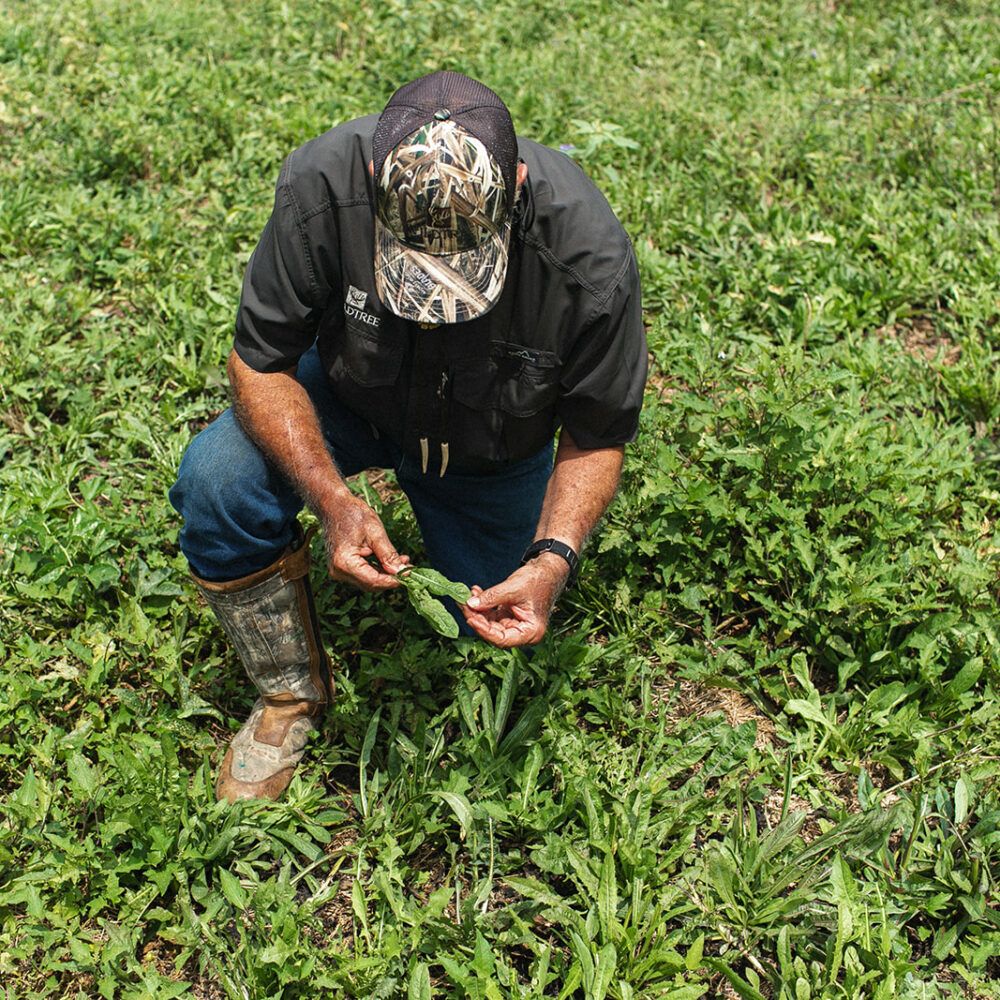
The safe answer to the question is, “Read the bottle.” It may be a few days, a few weeks, or even a few months before you can be certain that the glyphosate won’t just kill whatever you plant. Generally, the stronger the concentration of glyphosate you spray and the more you spray, the longer it will be before you can plant.
Food Plot Seed Final Thoughts
A really good food plot is a wonderful thing. It can be a great place to take a young kid or first timer to build awesome memories, and it can be a nice option for an experienced hunter who wants a “sure thing.” There are some who claim that good food plots are only good for attracting does and smaller bucks, but many of us know better. My dad’s PB buck was taken as he browsed next to a dozen other deer late one evening on a very well-done food plot.
But not just any patch of grass will draw and hold deer like that. You have to give them something they really want and need. Hopefully, this article takes you a step closer to that goal.

